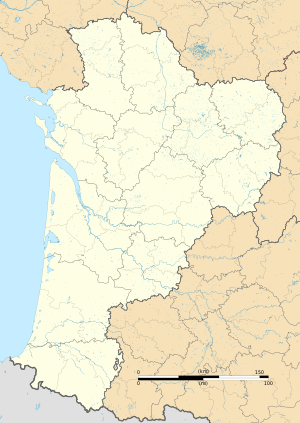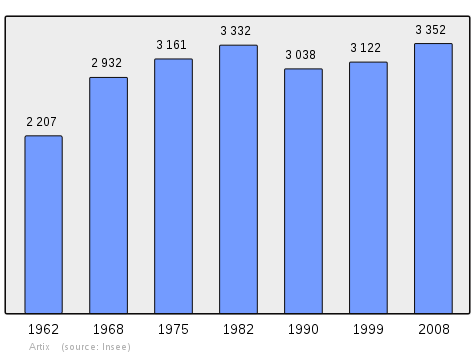Artix, Pyrénées-Atlantiques
Artix (French pronunciation: [aʁtiks]) is a commune in the Pyrénées-Atlantiques department in the Nouvelle-Aquitaine region of south-western France.
Artix | |
|---|---|
Artix Main Street | |
.svg.png) Coat of arms | |
Location of Artix 
| |
 Artix  Artix | |
| Coordinates: 43°23′54″N 0°34′14″W | |
| Country | France |
| Region | Nouvelle-Aquitaine |
| Department | Pyrénées-Atlantiques |
| Arrondissement | Pau |
| Canton | Artix et Pays de Soubestre |
| Intercommunality | CC Lacq-Orthez |
| Government | |
| • Mayor (2014-2020) | Jean-Paul Bergeret-Tercq |
| Area 1 | 9.11 km2 (3.52 sq mi) |
| Population (2017-01-01)[1] | 3,428 |
| • Density | 380/km2 (970/sq mi) |
| Time zone | UTC+01:00 (CET) |
| • Summer (DST) | UTC+02:00 (CEST) |
| INSEE/Postal code | 64061 /64170 |
| Elevation | 96–141 m (315–463 ft) (avg. 143 m or 469 ft) |
| 1 French Land Register data, which excludes lakes, ponds, glaciers > 1 km2 (0.386 sq mi or 247 acres) and river estuaries. | |
The inhabitants of the commune are known as Artisiens or Artisiennes.[2]
Geography
Artix is located some 12 km north-west of Lescar and 14 km south-east of Orthez. Access to the commune is by main road D817 from Lacq in the north-west passing through the commune and south of the town and continuing south-east to Denguin. Access to the town from the D817 is on the D280 which links the two ends of the bypass. There are also the D263 road going north to Urdès, the D663 going north-east to Serres-Sainte-Marie, the D32 going east to Cescau, and the D281 going south-east to join the D33 north-west of Noguères. The A64 autoroute also passes through the north-eastern corner with Exit 9 exiting to the D817 in the commune.[3]
The SNCF Toulouse-Bayonne railway line also passes through the commune with a station just south of the town centre. The Interurban network of Pyrénées-Atlantiques busline has two routes passing through the commune: Route 801 (Orthez-Pau) and Route 802 (Artix-Pau).
Apart from the town there are the villages of Cap de Lalanne and Le Plateau. Some 40% of the commune is residential with the balance farmland with patches of forest.[3]
The Gave de Pau flows north-west past the southern border of the commune with some branches touching the border. The Ruisseau Laulouze flows from the east through the south of the commune and joins Le Ruisseau which flows north-west parallel to the Gave de Pau until it joins the river west of the commune just south of Lacq. The Agle also flows west through the northern corner of the commune to join the Gave de Pau south of Lacq.[3]
Places and Hamlets[4]
- Près l'Agle
- Auta
- Les Baigts
- Baradat
- Bernata
- Cabille
- Cambayou
- Camous
- Campagnolle
- Candaus
- La Castanhère (château)
- Le Castérot
- Cité
- Cortigue
- Cuyala (Cor de)
- Les Esquirous
- Geil
- Les Grabes
- Labourdette
- Cap de Lalanne
- Larrecq
- Larrieu-Lôme
- Lauguère
- Laviecave[5]
- Lavignasse
- Lavigne
- Le Moulin
- Pendix
- Le Plateau
- Pondix
- Pont Mayou
- Porte Neuve
- Poumetche
- Rémy
- Rey
- Saligot
- Sarrailla
- Taulat
- Toch
Toponymy
The name Artix appears in the forms:
- Artits (1286[6]),
- Artics (13th century,[6] Fors de Béarn[7]),
- Artidz (1350,[6] Notaries of Pardies[8]),
- Artitz (1385,[6] Census of Béarn[7]),
- Arthitz (1440,[6] Census of Bastide-Monréjau[9]),
- Artixs (1538,[6] Reformation of Béarn[10]),
- Artix in 1583,[11] in the Reformation of Béarn,[10] and on the Cassini Map of 1750.[11][12]
Its name in béarnais is Artics. Michel Grosclaude[11] indicated that the name Artix possibly was formed from the mediterranean radical arte ("green oak" then "undergrowth") and the collective and locative basque suffix -itz. He proposed them in the sense "Vegetation of the undergrowth".
Laviecave is a hamlet mentioned in 1863[5] but Paul Raymond recommended the spelling La Vie-Cave, meaning the sunken way or path: la via cava.
History
The commune once had a Lay Abbey, vassal of the Viscounts of Béarn. In 1385 Artix was a small village under the bailiwick of Pau with only 10 fires grouped around the church.[6] In 1880 the old church was demolished. The new church was opened in 1899.[6]
The village became a city after the creation of the Royal Road under Henri IV which then became Imperial Route 117, then the Route nationale 117. This opening up allowed the market at Artix to flourish and the city to grow in importance.[13]
Heraldry
.svg.png) Arms of Artix |
The status of the blazon remains to be determined
Blazon: |
Administration
List of Successive Mayors[14]
| From | To | Name | Party | Position |
|---|---|---|---|---|
| 1960 | 1989 | Maurice Plantier | RPR | Councillor, MP |
| 1989 | 2001 | Raymond Elissonde | PS | |
| 2001 | 2008 | Jean-Paul Hau-Palé | ||
| 2008 | 2020 | Jean-Marie Bergeret-Tercq | PS |
(Not all data is known)
Inter-communality
The commune is part of five inter-communal structures:[15]
- the Community of communes of Lacq;
- the SIVU for the Agle and the Lacq;
- the association for water and sanitation of Trois Cantons;
- the Energy association of Pyrénées-Atlantiques;
- the inter-communal association for defence against flooding of the Gave de Pau;
Twinning
Artix has twinning associations with:[16]


Demography
In 2010 the commune had 3,471 inhabitants. The evolution of the number of inhabitants is known from the population censuses conducted in the commune since 1793. From the 21st century, a census of communes with fewer than 10,000 inhabitants is held every five years, unlike larger towns that have a sample survey every year.[Note 1]
| 1793 | 1800 | 1806 | 1821 | 1831 | 1836 | 1841 | 1846 | 1851 |
|---|---|---|---|---|---|---|---|---|
| 582 | 620 | 544 | 640 | 681 | 656 | 719 | 733 | 740 |
| 1856 | 1861 | 1866 | 1872 | 1876 | 1881 | 1886 | 1891 | 1896 |
|---|---|---|---|---|---|---|---|---|
| 742 | 710 | 734 | 718 | 741 | 740 | 754 | 765 | 742 |
| 1901 | 1906 | 1911 | 1921 | 1926 | 1931 | 1936 | 1946 | 1954 |
|---|---|---|---|---|---|---|---|---|
| 742 | 750 | 770 | 722 | 768 | 804 | 790 | 715 | 800 |
| 1962 | 1968 | 1975 | 1982 | 1990 | 1999 | 2006 | 2010 | - |
|---|---|---|---|---|---|---|---|---|
| 2,207 | 2,932 | 3,161 | 3,332 | 3,038 | 3,122 | 3,153 | 3,471 | - |

Economy
Artix has a prevention plan for technological risks due to some chemical establishments in the commune, similar to Bésingrand, Os-Marsillon, Noguères, Mourenx, and Pardies.
The Groupe Olano has a site in Artix specialising in the storage and transport of chocolate.
Culture and heritage
Religious heritage
The Parish Church of Saint-Pierre (19th century)![]()
Cultural and environmental heritage
The Béarnais polyphonic group Los Pagalhós, created in the 1970s, was born in Artix.
Villages in Béarn are permitted to display street signs in Occitan. Artix was the first commune in France of more than 3,000 inhabitants to implement Bilingual signs throughout the commune in occitan (Gascon béarnais) and French. Consequently, its signs show its name as "Artics", since the letter X is little used in the Bearnais dialect.
Artix also has an Occitan language school or Calandreta.
Facilities
Education
Artix has two elementary schools (Moulin and Sarrailh), one college (College Jean Moulin),[18] and one calandreta with a childcare nursery and a primary school.
Sports and associations
- Artix Basketball Club.[19]
Notable people linked to the commune
- Maurice Plantier, born in 1921 at Biarritz and died in 2006 at Paris, was a French politician. He was mayor of Artix from 1960 to 1989.
- Ramesh Kumar Nibhoria, born in Chandigarh , India, inventor of many biomass energy equipment for space heating and cooking. He is winner of many awards including Ashden Awards and has applied 16 patents. Since June, 2017, he started living here to explore bioenergy technologies business in France and Africa.
See also
External links
- Artix official website (in French)
- Artix on Lion1906
- Artix on Géoportail, National Geographic Institute (IGN) website (in French)
- Artix on the 1750 Cassini Map
Notes and references
Notes
- At the beginning of the 21st century, the methods of identification have been modified by Law No. 2002-276 of 27 February 2002 Archived 6 March 2016 at the Wayback Machine, the so-called "law of local democracy" and in particular Title V "census operations" allows, after a transitional period running from 2004 to 2008, the annual publication of the legal population of the different French administrative districts. For communes with a population greater than 10,000 inhabitants, a sample survey is conducted annually, the entire territory of these communes is taken into account at the end of the period of five years. The first "legal population" after 1999 under this new law came into force on 1 January 2009 and was based on the census of 2006.
References
- "Populations légales 2017". INSEE. Retrieved 6 January 2020.
- Inhabitants of Pyrénées-Atlantiques (in French)
- Google Maps
- Géoportail, IGN, consulted on 15 April 2012 (in French)
- Topographic Dictionary of the Department of Basses-Pyrenees, p. 97
- Topographic Dictionary of the Department of Basses-Pyrenees, Paul Raymond, Imprimerie nationale, 1863, Digitised from Lyon Public Library 15 June 2011, p. 14 (in French)
- Manuscript from the 14th century - Departmental Archives of Pyrénées-Atlantiques (in French)
- Notaries of Pardies - Departmental Archives of Pyrénées-Atlantiques (in French)
- Manuscript of 1440 - Departmental Archives of Pyrénées-Atlantiques (in French)
- Manuscript from the 16th to 18th centuries - Departmental Archives of Pyrénées-Atlantiques (in French)
- Michel Grosclaude, Toponymic Dictionary of communes, Béarn, Edicions reclams & Édition Cairn - 2006, 416 pages, ISBN 2 35068 005 3 (in French)
- Cassini Map 1750 - Artix
- Brigitte Jobbé-Duval, Dictionary of place names - Pyrénées-Atlantiques, 2009, Archives and Culture, ISBN 978-2-35077-151-9 (in French)
- List of Mayors of France (in French)
- Intercommunality of Pyrénées-Atlantiques Archived 2014-05-02 at the Wayback Machine, Cellule informatique préfecture 64, consulted on 20 March 2012 (in French)
- National Commission for Decentralised cooperation (in French)
- Ministry of Culture, Mérimée IA64000511 Parish Church of Saint-Pierre (in French)
- Jean Moulin College website (in French)
- Artix Basketball website (in French)
| Wikimedia Commons has media related to Artix (Pyrénées-Atlantiques). |